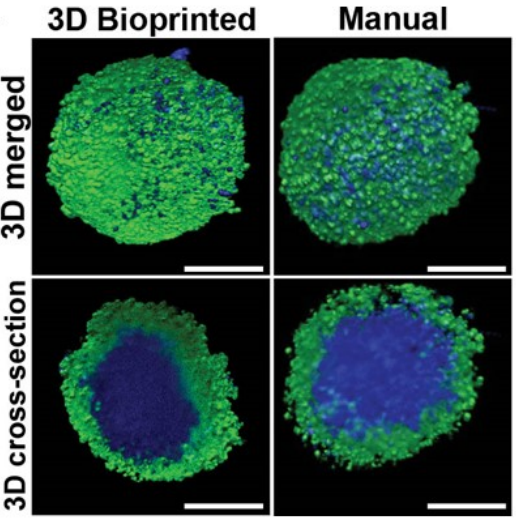At a time when experts predict cancer will remain a massive health problem, advances in technology can make a big difference. Earlier this year, the World Health Organization (WHO) announced that, if current trends continue, the world will see a 60% increase in cancer cases over the next two decades. Even with this ghastly prediction hovering over the human race, advances in personalized medicine, modifications in drug development, and cell-based therapy can still change the road ahead. For many labs that traditionally relied on 2D in vitro cell cultures and animal models for oncology research, the field is shifting as companies continue to develop and upgrade bioprinting technology to help recreate cancer microenvironments.
After several years of exploring potential breakthroughs to remove the need for time-consuming manual labor in medical labs and offer scientists a faster way to recreate tumor models, molecular biologist and engineer Julio Ribeiro co-founded in 2013 biomedical company Inventia Life Science. Ribeiro set out to develop core technology in digital bioprinting, realizing that a rapid droplet-based platform would be needed to deliver the speed and complexity of printed tissues. Along with co-founder Aidan O’Mahony, he developed a 3D bioprinting platform called RASTRUM that can rapidly print human cells to help with cancer drug testing. The recognizable pink printer emulates ink-jet technology to reproduce different types of realistic tumors for testing cancer drugs. Even though bioprinting research is booming in Australia, there are very few firms commercializing the technology. We interviewed Inventia Life Sciences CEO Julio Ribeiro to understand how the company and its platform is supporting cancer research.
Why did you become interested in bioprinting?
I was closely following the emergence of 3D bioprinting in the early 2000s and was inspired by the transformative potential of the technology. Based on my experience in the life science industry, I could see that, if the capability was applied intelligently to the creation of microtissues for biomedical research and drug discovery, through a simple and user-friendly platform, it could rapidly accelerate research with an impact similar to the advent of PCR [polymerase chain reaction] technology. By building a sustainable foundation for the business and technology-based on this application, would provide a fantastic launching pad to extend the use of the technology into tissue engineering and regenerative medicine.
Is bioprinting providing the tools that the healthcare industry needs to become digitized?
Despite significant technology advances, there are still aspects of biomedical research, drug discovery and healthcare that rely on surprisingly archaic processes. For example, much of pre-clinical drug discovery is still conducted by testing compounds against cells growing on 2D plastic surfaces, or in laborious manually-generated models that limit throughput and statistical power. Processes like these are inefficient, often impossible to reproduce, and are a grossly inadequate way to commence a drug development process that could take 10 to 15 years and billions of dollars. We are definitely seeing the convergence of technologies in automation, big data and biology to massively shift the speed and scale of biomedical research. The RASTRUM platform has an important role to play in that transformation by enabling the creation of biological tissues with a speed, scale and reproducibility that has not previously been possible. This same capability will, in the longer term, enable new paradigms of treatment through tissue engineering and regeneration.

3D bioprinted spheroids using RASTRUM have a similar organization as manually produced spheroids, but enable high-throughput drug response analysis from paper Precise, high-throughput production of multicellular spheroids with a bespoke 3D bioprinter (Credit: Inventia Life Sciences)
How will your technology help oncology research?
RASTRUM has huge potential in the field of cancer research, personalised and regenerative medicine. As part of this, it can accelerate the drug testing process, being able to test hundreds of new drug candidates against cancer cells in a fraction of the time it would normally take. With the combination of speed and precision, it can produce cell models that can’t be produced using other methods in a matter of hours. Importantly, it is gentle and uses less cells than other 3D cell model approaches, which is beneficial when handling precious patient derived cells or sensitive neural cells.
How is Inventia’s technology different from competing bioprinters?
RASTRUM has been designed as a holistic platform with cell biologist users in mind and by interconnecting the proprietary bioinks with its specialised printing mechanics. At its core, RASTRUM features drop-on-demand technology, which is similar to the way a household ink-jet printer works. The technology enables non-contact printing of tiny droplets of cells and matrix components in a very fast, and precise manner that is gentle on cells. It’s design philosophy enables a simple plug-print-play approach with the high throughput capability of producing hundreds of 3D cell models per hour. The RASTRUM proprietary hydrogels are unique in their ability to be tailored to different cell and tissue types by changing stiffness and biofunctionality, thus mimicking the native environment of animal and human tissues. Moreover, they undergo strict validation, quality control and sterilisation prior to release to the customer, to ensure that there is no batch-to-batch variation and a high degree of reproducibility is always maintained.
And what makes the platform so unique?
The user interface features simple, end-to-end workflow driven software that intuitively guides the researcher through the entire bioprinting process. RASTRUM’s pre-validated protocols (including self cleaning, matrix preparation and 3D model design) require no prior bioprinting knowledge or experience and enable the user to focus their time on their experimental outcomes rather than worry about the 3D printers parameters. The 3D cell models that it generates mimic healthy and diseased human tissue, such as that found in cancer, and can be created in high-throughput with a range of applications including drug screening, personalised medicine and tissue regeneration.
Does the use of 10 independently addressable nozzles make a big difference to the end result?
The device has been built with the future goals of its users in mind. By incorporating 10 independently addressable nozzles into its print head, it is capable of simultaneously printing multiple cell types and matrix components, which cannot be achieved by current methods. This process not only saves time, but also enables the generation of complex 3D cell models with more than 1 cell type in the same experiment.
Up until now, what research has been done using the RASTRUM?
It has been used in a wide range of research areas by our customers and collaborators. The generation of complex co-culture models featuring multiple cell types has been explored, particularly in immuno-oncology cancer research on solid tumours looking at the interaction of the immune cells with cancer cells. The modulation of the matrix environment has also been extensively explored by incorporating various growth factors, cell adhesion peptides and full length proteins in RASTRUM’s proprietary hydrogels to mimic the various cell behaviours in diseased and healthy tissue.
Furthermore, RASTRUM has also been used for the purposes of drug screening to study the interaction between drugs and cells. These studies have focused on printing simple 3D models containing cells, using both established cell lines (heart, lung, skin, liver, neural cells) and patient-derived cells taken from biopsies. It’s compatibility with a wide range of automated imaging and analysis techniques enables researchers to screen large libraries of compounds and drug candidates in high-throughput.
Does Inventia handle its own research lab?
Inventia has its own biological research lab on site at headquarters in Sydney. This is where the team develops new bioinks and validates the various cell types that can be printed using RASTRUM. In addition to our in-house development, Inventia Life Science has a large number of collaborators in Australia and abroad, who are using RASTRUM to develop and validate new cell models and applications. The engineering and manufacturing of the machine is also done at our Sydney site which makes us proudly Australian owned and operated.
Talking about Australia’s bioprinting environment, would you say it’s moving very fast?
Australia is and has been at the forefront of biomedical research for many years. We have many world-class institutions and a community of research scientists with an exceptional and globally-recognised track record. We also have great strength in engineering and technology, and excellent health systems. This is fertile ground for the development of innovative biomedical technologies, as we’ve seen with medical device success stories in Australia in the past. It is often said that Australia punches above its weight in research and innovation, but falls behind in getting those great ideas to market. While this may be true of recent history, with new opportunities and an increase in public and private funding, we believe we are witnessing an emergence of a new industry in the country and Inventia Life Science is excited to help drive that transformation.
What is Inventia’s next project?
There are a few very exciting projects in the pipeline for the team at Inventia. In particular the work that is underway with clinical partners to advance regenerative medicine in areas such as bioprinted skin for burns and wounds. Other areas that we are actively exploring include personalised medicine, where a small portion of a biopsy taken from a patient could be used to produce a range of cell models to be screened against a library of drugs. We are also working towards the development of 3D lung models for the use in COVID-19 drug research.
What can we expect for the bioprinting industry in the next decades?
Bioprinting is a field that is growing extremely fast. It will definitely have enormous impacts on the acceleration of drug testing, as well as the field of personalised medicine where a tissue sample will be taken from a patient suffering from cancer or other disease, and screened against hundreds of drugs to find the best possible treatment regime. As part of its recent success, RASTRUM has been recognised in FAST Company’s World Changing Ideas awards, as the winner in the Experimental Category. This recent achievement speaks to the importance of 3D bioprinting and recent advances that have been made using RASTRUM. The work being carried out is building a solid foundation for future research into the generation of human tissue for transplants.
Subscribe to Our Email Newsletter
Stay up-to-date on all the latest news from the 3D printing industry and receive information and offers from third party vendors.
You May Also Like
Gorilla Sports GE’s First 3D Printed Titanium Cast
How do you help a gorilla with a broken arm? Sounds like the start of a bad joke a zookeeper might tell, but it’s an actual dilemma recently faced by...
Nylon 3D Printed Parts Made More Functional with Coatings & Colors
Parts 3D printed from polyamide (PA, Nylon) 12 using powder bed fusion (PBF) are a mainstay in the additive manufacturing (AM) industry. While post-finishing processes have improved the porosity of...
$25M to Back Sintavia’s Largest Expansion of Metal 3D Printing Capacity Since 2019
Sintavia, the digital manufacturing company specializing in mission-critical parts for strategic sectors, announced a $25 million investment to increase its production capacity, the largest expansion to its operations since 2019....
Velo3D Initiates Public Offering in a Bid to Strengthen Financial Foundations and Drive Future Growth
Velo3D (NYSE: VLD) has been among a number of publicly traded 3D printing firms that have attempted to weather the current macroeconomic climate. After posting a challenging financial report for 2023,...

































